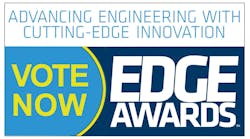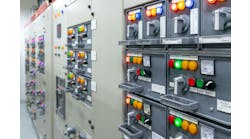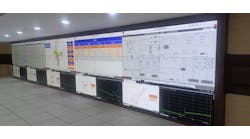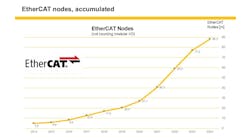"We're implementing the Digital Enterprise now because it can speed time to market, improve flexibility and efficiency, deliver consistent quality, and do it securely," says Raj Batra, president of the Digital Factory division, Siemens.
Users in the process and discrete industries are always pressing for more flexibility and innovation—and now the digital disruption race is on, too—but Siemens has the technical answers ready for users in all sectors to gain the edge they need, according to Raj Batra, president of the Digital Factory division at Siemens, who delivered the opening keynote address at Siemens Automation Summit 2018 on June 25-28 in Marco Island, Fla."It's estimated there will be 77 million wearable computing devices in use for a projected revenue of $48.2 billion by 2023, while the digital economy is expected to grow to 6.5% of GDP, and 38% of CEOs are worried about the speed of technological change," said Batra. "The solutions to these challenges can especially be seen at Automation Summit. The market calls these challenges 'digitalization,' we know our users call it 'just doing your job.' "
Batra explained the technical trajectory towards digitalization is clear. "Up to and including the 1990s, there was increasing productivity as more manufacturing processes were automated, but many control systems were still 35 years old," said Batra. "In the 2000s, more design and engineering, and the first steps toward integrating automation and engineering, allowed more gains. However, today is where the real gains can be made thanks to digitalization technologies and digital twin simulations that reduce time to market, enable mass customization, and allow real step changes by combining the real and digital worlds."
Where the worlds of automation and software used to be separate, Batra added that Siemens has invested about $10 billion in recent years to combining its physical automation products more closely with its product lifecycle management (PLM) and other software solutions. "Huge gains can be made when we bring together our common digital threads and models," added Batra.
Digital across applications
Where automakers previously used non-integrated solutions to develop and simulate vehicles, adjusted automation systems onsite, and suffered costly downtimes due to unexpected defects, Batra reported they're now shortening time-to-market by integrating all development phases, programming automation before construction and production, and detecting faults before they cause problems. Likewise, where food and beverage producers formerly had long development, commissioning and conversion periods, as well as minimal product diversity and quality fluctuations, they're now using holistic plant simulation to increase production flexibility, speed up commissioning, and improve data transparency for better quality.
"For example, Constellation Brands' Nava plant in Mexico is the world's largest brewery, producing about 200 million cases per year," added Batra. "It recently partnered with Siemens to automate and modernize, and standardize the hardware and software of more than 30 suppliers, which helped it triple its annual output, while still maintaining product quality.
In addition, where many chemical applications used to produce large batch using inflexible processes, they're using digitalization to produce smaller batches, which can be made with more flexibility because they've been simulated prior to actual production, and digitally documented to detect faults earlier. Specifically, a recent collaboration with Siemens enabled Merck to implement modular automation units that could dock with a larger backbone, and plug and produce pharmaceuticals with minimal engineering time.
"We're implementing the Digital Enterprise now because it can speed time to market, improve flexibility and efficiency, deliver consistent quality, and do it securely," concluded Batra.
Customer excellence awards
Following the keynote address, Siemens presented its 2018 Customer Excellence Awards to four winning end users, including:
- Deutsche Beverage Technology (DBT) in Charlotte, N.C., provides more than 1,000 craft brewers from 3.5 barrels to more than 240 barrels with digital systems, remote access, smart controls and integrated process system communications technologies. It's been a Siemens customer for seven years, and uses TIA Portal with S71200, S71500 and Sinamics controllers, G120 drives, WinCC SCADA and WinCC Advanced, and other controls and networking devices to complete a turnkey automation package for the craft brewing industry.
- Fresenius Medical Care North America produces a treatment for peritoneal dialysis (PD), and serves 80% of patients in the eastern U.S. It recently built a new device and disposables manufacturing plant in Knoxville, Tenn., but it faced a fixed deadline for starting production, which also meant it needed a robust, reliable, modular and standardized control system. The functional design specification was written by Cross Co., which compared its recommended SCADA options to Siemens Simatic PCS 7 controls with batch configuration based on its short development time, lack of customization required due to its standard function blocks, block icons and faceplates. The plant's recipes are used for PD solution batching, filling, cleaning and sanitizing, but its applications must also be 21 CFR Part 11 compliant, reduce manual entries, and able to expand.
- Ascent Aerospace in Santa Ana, Calif., has been a Siemens customer for three years, and uses advanced motion equipment in its mobile work platforms for assembling aircraft, automated wing rotation fixtures, and fabricating and assembling rocket components. It uses Siemens for all motion types, including CNC, S120 drives with Tech PLC and Simotion, and VFDs. For example, Ascent deployed Sinamics G120D drives and Sirius ACT pilot devices with Profinet gateways in its mobile platforms, which needed semi-automatic operation with decentralized power distribution and motion with centralized control. It also used remote ET200 Pro Motor starters for actuator control. In its automated wing unit, Ascent used Sinamics S120 servo controlled clamps and Sinamics CU320 controls. Finally, its multiple rocket building work cells use Sinumerik 840D drive controls, Run My Robot software and S7-1500T controllers.
- Kelly Slater Wave Co. (KSWC) in Lemoore, Calif., creates the longest, rideable, open-barrel, man-made waves at its Surf Ranch with help from Timberland Equipment Ltd. and Siemens technology, including SM150 MV drives and motors, Simatic S7 PLCs, TP1900 panel HMIs, KTP900F mobile pendant HMIs, safety I/O, TR CDV75 dual-safety encoders, ProfiSafe communications protocol, and Scalance X208 networking, W788 wireless and Fiber Ring HSR network modules. These controls and components balance the forces between two 3,000-hp winches, pulling a massive vehicle over 2,000 feet, enabling KSWC to create 6-foot barreling waves every three minutes, which give surfers a 45-second ride about 140 times per day.
Recent innovation
In other news at Siemens Automation Summit 2018:
- Rainer Brehm, vice president for Automation Products and Systems, Siemens AG, reported that IEEE Time-Sensitive Networking (TSN) will be integrated with OPC-UA and Profinet protocol, which will enable real-time communication using standard microprocessors. TSN will increase Profinet's bandwidth to 1 Gbit, and enable it to use client-server, publish-subscribe (pubsub) and pubsub TSN technology.
- Dr. Hartmut Klocker, vice president for Automation & Engineering Systems, Siemens, and Axel Lorenz, vice president of sales and Verticals Process Automation, Siemens, reported that its Simatic PCS7, V9.0, has a new hardware platform based on Profinet protocol, small footprint, single-point-configurable I/O, high-availability remote I/O, and field device commissioning, which combine to deliver digitalization down to the field level.
- Klocker and Lorenz also presented Siemens MindTwin digital asset portal that includes XHQ for visualization and navigation; Comos virtual plant for design and reference, Walkinside 3D spatial software, and Mindsphere for analytics. They also demonstrated Simit, V10, virtual commissioning and operator training platform, and showed how Comos, PCS 7 controllers, Simit and Process Instrumentation and Analytics (PIS) lifecycle portal can work together.







